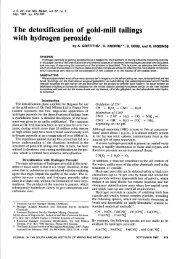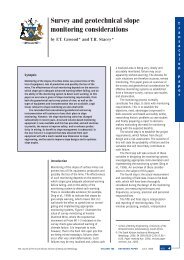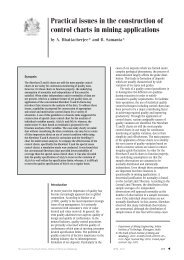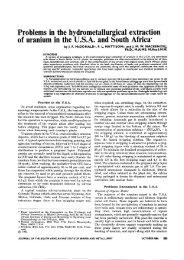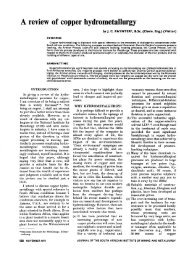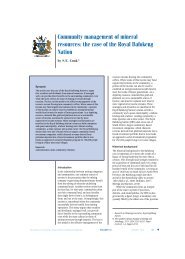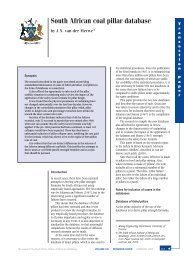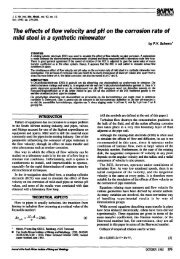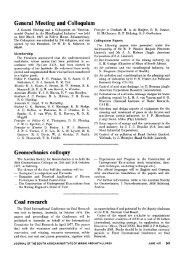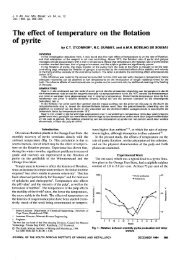Investigation of factors influencing the determination of ... - saimm
Investigation of factors influencing the determination of ... - saimm
Investigation of factors influencing the determination of ... - saimm
Create successful ePaper yourself
Turn your PDF publications into a flip-book with our unique Google optimized e-Paper software.
A case study on stoping shift buffering at Impala platinum<br />
methodology in South Africa. This new methodology places<br />
emphasis on <strong>the</strong> management <strong>of</strong> <strong>the</strong> uncertainties that<br />
always accompany projects.<br />
Critical chain project management<br />
The critical chain project management (CCPM) philosophy<br />
was introduced to <strong>the</strong> commercial world in <strong>the</strong> late 1990s by<br />
an Israeli philosopher Eliyahu M. Goldratt. Simply stated, it is<br />
a <strong>the</strong>ory <strong>of</strong> constraint (TOC) way <strong>of</strong> managing projects.<br />
The key aspects <strong>of</strong> CCPM are that it:<br />
➤ Pays detailed attention to resource contention during<br />
<strong>the</strong> scheduling process<br />
➤ Limits and discourages bad multi-tasking<br />
➤ Takes into account <strong>the</strong> tendencies <strong>of</strong> people to procrastinate<br />
getting down to work or to divide work evenly<br />
throughout <strong>the</strong> estimated duration <strong>of</strong> work<br />
➤ Uses <strong>the</strong> as-late-as-possible (ALAP) scheduling<br />
process<br />
➤ Acknowledges <strong>the</strong> inherent existence <strong>of</strong> uncertainties<br />
in projects and attempts to quantifiably manage <strong>the</strong>m<br />
through a process known as ‘buffer management’<br />
(Leach, 20042; Newbold, 19984; Goldratt, 19985).<br />
Critical chain methodology<br />
➤ Scheduling phase—The scheduling phase <strong>of</strong> CCPM is<br />
basically <strong>the</strong> same as that for critical path scheduling.<br />
In fact, without resource contention, <strong>the</strong> critical path is<br />
<strong>the</strong> same as <strong>the</strong> critical chain. The major difference is<br />
that in CCPM <strong>the</strong> project due date is set and<br />
protected/buffered against uncertainties. In simple<br />
terms, all task durations are halved prior to resource<br />
levelling. The remaining half <strong>of</strong> <strong>the</strong> task durations are<br />
ploughed back into <strong>the</strong> project plan as a protection <strong>of</strong><br />
<strong>the</strong> project due date, which is known as <strong>the</strong> project<br />
buffer. This whole process <strong>of</strong> halving task durations is<br />
carried out so as to eliminate <strong>the</strong> adverse human<br />
behaviours that can interfere with task execution. The<br />
critical chain is <strong>the</strong>n identified as <strong>the</strong> longest chain <strong>of</strong><br />
dependent events taking into account <strong>the</strong> resource<br />
contention2.<br />
➤ Execution and monitoring phase—In CCPM, resources<br />
are forced to prioritize tasks that are on <strong>the</strong> critical<br />
chain. ‘Bad multi-tasking’† is eliminated by releasing—<br />
as a rule <strong>of</strong> thumb—only three tasks per resource at<br />
any given time. The project monitoring phase during<br />
execution involves monitoring <strong>the</strong> amount <strong>of</strong> buffers<br />
consumed vis-à-vis <strong>the</strong> percentage <strong>of</strong> <strong>the</strong> critical chain<br />
completed5. The practical application <strong>of</strong> <strong>the</strong>se principles<br />
is described in <strong>the</strong> following section.<br />
CCPM application: case study on stoping shift<br />
buffering<br />
†Bad multi-tasking may be considered as working on many concurrent<br />
tasks/paths that have an adverse effect on lead times, although effort<br />
and touch time remain unchanged.<br />
Case study background<br />
Although Impala Platinum’s average monthly stoping productivity<br />
was 17m/month, its leadership was concerned that <strong>the</strong><br />
overall stoping performance had plateaued and was starting<br />
to deteriorate. Impala Platinum, through its Best Practice<br />
Department, initiated an Accelerated Productivity<br />
Improvement programme (API) aimed at improving <strong>the</strong><br />
overall productivity <strong>of</strong> <strong>the</strong> organization. It is a noteworthy<br />
observation that a metre improvement in productivity <strong>of</strong> <strong>the</strong><br />
whole organization translated to a more than R1 billion<br />
increase in annual sales in <strong>the</strong> 2007 financial year (turnover<br />
<strong>of</strong> R17 billion at 17 metres per month). In addition,<br />
improving stoping productivity is a fundamental step towards<br />
achieving annual business plans.<br />
The API programme started with an industrial<br />
engineering study at Impala No.12 shaft for <strong>the</strong> period<br />
between October 2006 and January 2007. The objective <strong>of</strong> <strong>the</strong><br />
study was to identify <strong>the</strong> reasons for <strong>the</strong> fact that some<br />
stoping crews’ performance were falling short <strong>of</strong> <strong>the</strong>ir<br />
monthly targets/blasts. It was anticipated that <strong>the</strong> causes <strong>of</strong><br />
lost blasts could broadly be classified into three areas:<br />
➤ Input constraints—system limitations caused by underresourcing<br />
<strong>of</strong> human, physical, information, and/or<br />
financial inputs<br />
➤ Output constraints—system limitations caused by <strong>the</strong><br />
inability to move <strong>the</strong> broken rock from <strong>the</strong> stopes<br />
➤ Capacity constraints—constraints in capacity that<br />
meant that it was not possible to complete all <strong>the</strong><br />
stoping tasks in <strong>the</strong> available shift time.<br />
The focus <strong>of</strong> <strong>the</strong> study was on <strong>the</strong> stoping capacity<br />
constraint, and only <strong>the</strong> day shift (drilling) will be discussed<br />
here. Inbound and outbound logistics and development<br />
(including construction and equipping) studies were also<br />
conducted, but <strong>the</strong>se do not form part <strong>of</strong> this paper. The<br />
project team used both qualitative and quantitative research<br />
methodologies.<br />
CCPM application methodology<br />
The project team used <strong>the</strong> following methodology, which is<br />
based on research, correlation and implementation:<br />
Stoping research study at Impala No. 12 shaft<br />
Initially <strong>the</strong> project team did not know what <strong>the</strong> stoping<br />
capacity constraints were, o<strong>the</strong>r than management<br />
hypo<strong>the</strong>ses. The project team set out to ga<strong>the</strong>r as much<br />
relevant data during time and motion studies.<br />
Competent observers tracked selected stoping crews for<br />
both <strong>the</strong> day and night shifts and observed time from start <strong>of</strong><br />
shift (SOS) to end <strong>of</strong> shift (EOS) and motion from shaft bank<br />
to bank.<br />
The study was conducted on four panels, two <strong>of</strong> <strong>the</strong>se<br />
being benchmark panels and <strong>the</strong> o<strong>the</strong>r two comparison<br />
panels.<br />
Comparing and correlating <strong>the</strong> study results with best<br />
practice<br />
The stoping resource schedule as shown in Figure 1 reveals<br />
<strong>the</strong> following:<br />
➤ Time and motion studies average performance <strong>of</strong> <strong>the</strong><br />
operator tasks were completed faster when compared to<br />
<strong>the</strong> time allowed in <strong>the</strong> best practice—stoping resource<br />
schedule.<br />
▲<br />
794 NOVEMBER 2011 VOLUME 111 The Journal <strong>of</strong> The Sou<strong>the</strong>rn African Institute <strong>of</strong> Mining and Metallurgy



